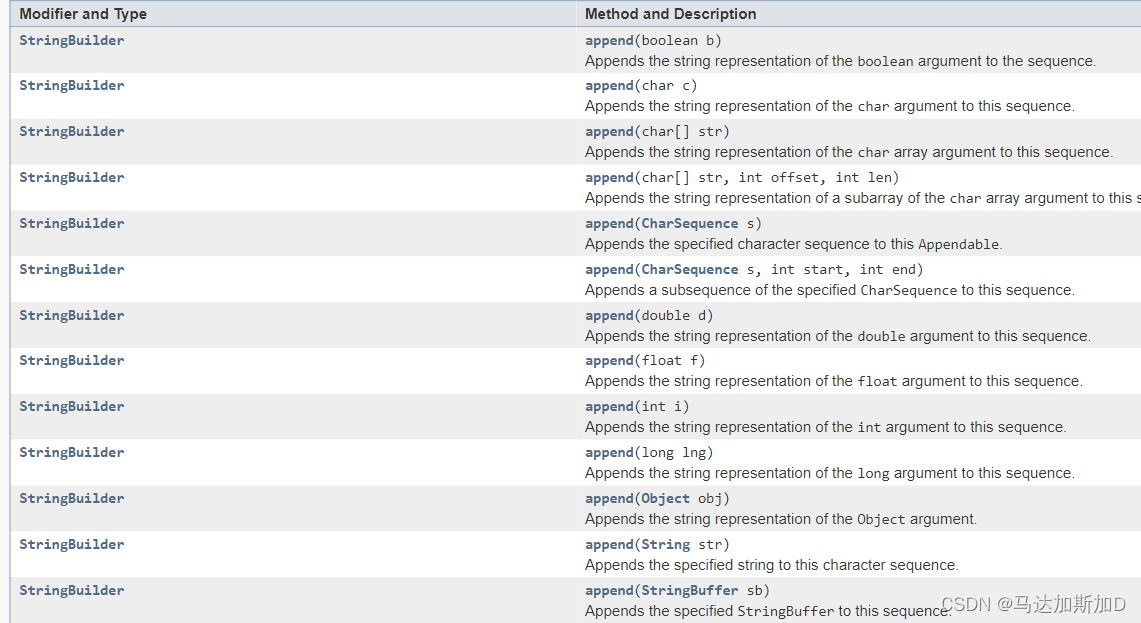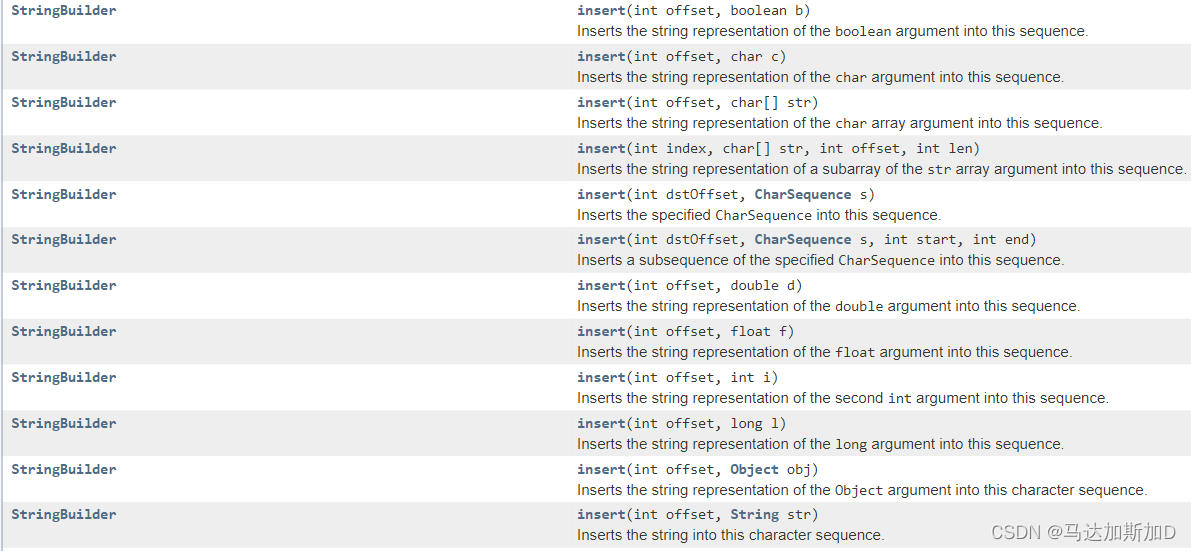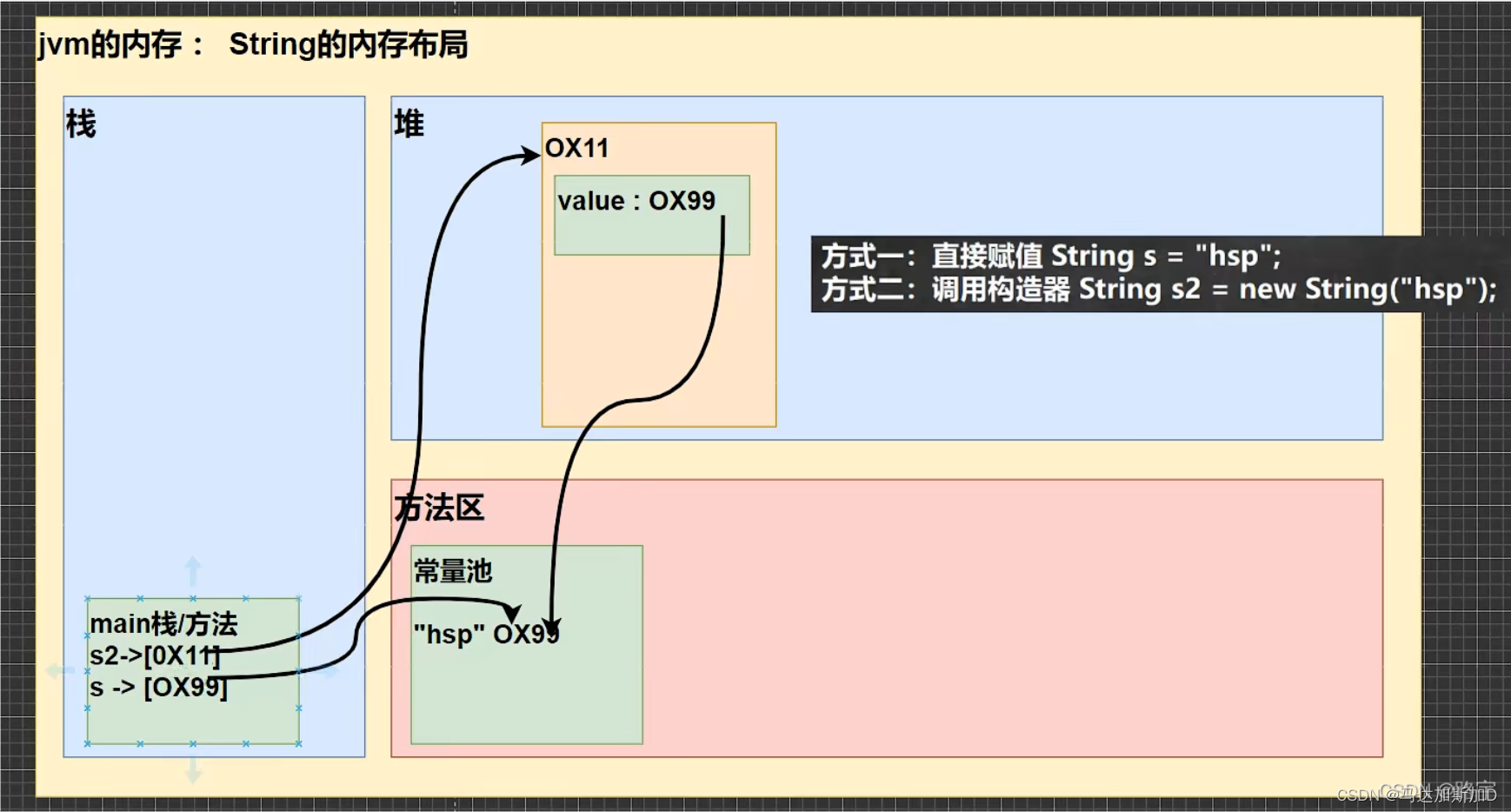Java 基础 --- String, StringBuilder, StringBuffer
String
String的声明方式
- 直接赋值: String s = “hello world” — 储存在常量池
- 调用构造器 String s = new String(“hello world”) ---- 储存在堆中的地址
- JVM为了提高性能和减少内存开销,在实例化字符串常量的时候进行了一些优化, 为字符串开辟一个字符串常量池,类似于缓存区
- 直接赋值时,首先坚持字符串常量池是否存在该字符串. 所以如果再次创建一个 String ss = "“hello world”. 将会和 s 指向同样的字符串常量
String的不可变性
- String类声明为final, 所以不能被继承
- String类实际储存字符串数据的是类内部的成员变量
final char [] value
- 因为value被final修饰, 所以value不能指向新的地址也就是不能再引用其他String变量
- String 内部没有改变 value 数组的方法,也就是不能更改String中任何一个char 元素, 因此可以保证 String 不可变。
String不可变性的体现: 只要对string做出修改, 就会开辟新的内存空间
- 1.当对字符串重新赋值时,会重新开辟新的内存空间储存新的字符串
//常量池中会同时储存 "hello world" 和 "hello" , 而不是 "hello world" 被覆盖掉
String s = "hello world"
s = "hello"
public static void main(String args[]) {
String s = "hello";
String temp = s;
s = "world";
String ss = "hello";
if (ss == temp) {
//注意这里对比的是地址, 说明ss和temp指向同样的地址
//也就是 "hello" 没有被world覆盖掉
System.out.println("same");
}
}
output: "same"
- 2.当对现有的字符串进行连接操作时,会重新开辟新的内存空间储存拼接后的字符串
- 3.当调用String的
replace().或者substring()等方法修改指定字符或字符串时,也会重新开辟新的内存空间储存修改后的字符串
public static void main(String args[]) {
String s = "hello";
String temp1 = s;
s = s + "world" ;
String temp2 = s;
if (temp1 != temp2) {
System.out.println("not same");
}
}
output: "not same"
对比两个String
- 使用 == 对比两字符串时实际对比的是地址, 而不是实际内容
- 所以一律使用
s1.equals(s2)或者s1.compareTo(s2)对比string
public static void main(String args[]) {
String s = "hello";
String ss = "hello";
String sss = new String("hello");
System.out.println(s == ss);
System.out.println(s == sss);
System.out.println(ss == sss);
}
output:
true // 因为 直接赋值创建String时, JVM会首先在常量池中寻找是否已经有同样的字符串. 所以s和ss指向同样的地址
false //使用构造器创建String时, 地址会指向堆内存, 然后堆内存中的地址指向常量池, 所以不一样
false //同上
Another example:
public class Solution {
static public String fun1(String s1) {
return s1;
}
public static void main(String args[]) {
String s = "hello";
String ss = fun1(s);
System.out.println(s == ss);
}
}
ouput: true
//但是如果在fun1中对s1进行任何修改, 如拼接等, 就会开辟新的内存空间, 则 s != ss
StringBuilder
- 如果代码中需要对string进行大量修改, 则推荐使用 StringBuilder类
- StringBuilder 类的对象能够被多次的修改,并且不产生新的未使用对象
Example:
public void pathToStartValue(TreeNode node, int startValue, String pathStart) {
if (node == null) {
return;
}
if (node.val == startValue) {
pathTostartValue = pathStart;
return;
}
//这里pathStart + "U" 会生成新的String, 最后导致内存超限
//所以需要改用StringBuilder
pathToStartValue(node.left, startValue, pathStart + "U");
pathToStartValue(node.right, startValue, pathStart + "U");
return;
}
- StringBuilder提供对String的增删改查, 包括:
append:

insert

setCharAt
void setCharAt(int index, char ch)
//The character at the specified index is set to ch.
delete
StringBuilder delete(int start, int end)
//Removes the characters in a substring of this sequence.
StringBuilder deleteCharAt(int index)
//Removes the char at the specified position in this sequence.
replace
StringBuilder replace(int start, int end, String str)
//Replaces the characters in a substring of this sequence with characters in the specified String.
substring
String substring(int start)
//Returns a new String that contains a subsequence of characters currently contained in this character sequence.
String substring(int start, int end)
//Returns a new String that contains a subsequence of characters currently contained in this sequence.
StringBuilder 和 StringBuffer 的区别
- StringBuilder 类在 Java 5 中被提出,它和 StringBuffer 之间的最大不同在于 StringBuilder 的方法不是线程安全的(不能同步访问)。
- 由于 StringBuilder 相较于 StringBuffer 有速度优势,所以多数情况下建议使用 StringBuilder 类。
